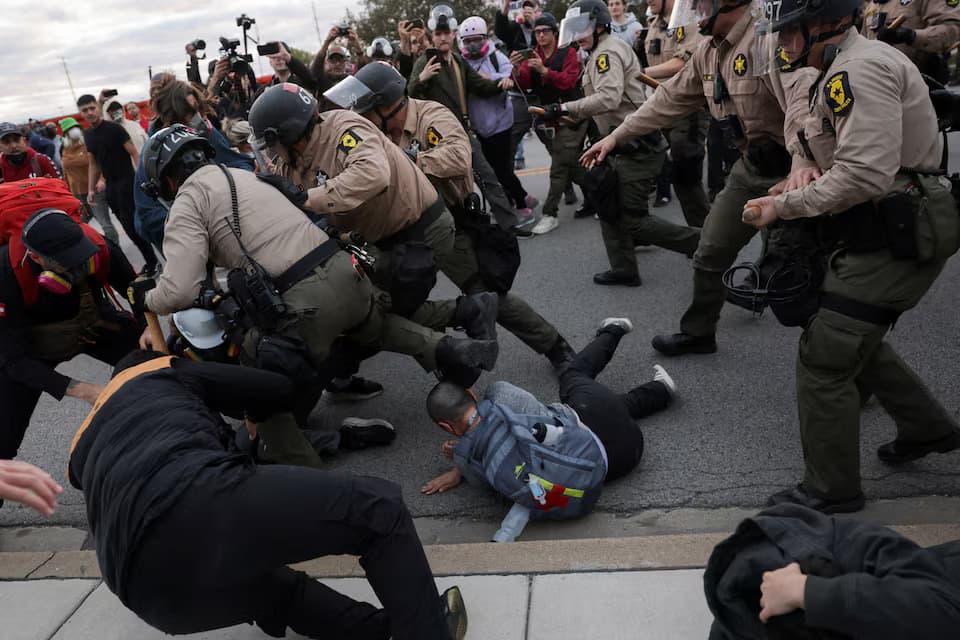Loading News Article...
We're loading the full news article for you. This includes the article content, images, author information, and related articles.
We're loading the full news article for you. This includes the article content, images, author information, and related articles.
Recent confrontations between law enforcement and demonstrators in Chicago highlight a recurring global challenge concerning the right to peaceful assembly and police conduct, resonating with similar concerns raised in Kenya.

At least 15 individuals were detained in the Chicago area on Friday, October 17, 2025, following clashes between Illinois state police and protesters outside the Broadview Ice detention centre. Tensions escalated when authorities attempted to enforce designated 'protest zones' and clear roadways, leading to officers reportedly tackling and dragging several demonstrators. Much of the confrontation was captured on video and circulated on social media, showing protesters attempting to intervene as a fellow demonstrator was apprehended. Chants of 'Who do you protect?' reportedly echoed through the crowd, as reported by the Chicago Sun-Times.
Protester and congressional candidate Kat Abughazaleh stated she was struck in the face with a baton and witnessed an officer push a woman to the ground. She criticised the concept of 'free speech zones,' arguing it implies restrictions elsewhere. Illinois state police confirmed that the 15 detained individuals, aged between 23 and 44, face charges including resisting, obstruction, or disobeying an officer.
The events in Chicago draw parallels with ongoing discussions and incidents regarding the right to protest and police response in Kenya. Kenya's 2010 Constitution, under Article 37, guarantees every person the right to assemble, demonstrate, picket, and present petitions peacefully and unarmed. However, this right is not absolute and is subject to restrictions provided by law, particularly those concerning national security, public safety, health, ethics, and the rights and freedoms of others.
Despite these constitutional guarantees, human rights organisations and civil society groups have frequently raised concerns about the use of excessive force by Kenyan police during protests. Reports from organisations like Human Rights Watch and Amnesty International Kenya have documented killings, illegal arrests, beatings, and the indiscriminate use of tear gas and water cannons to suppress demonstrations.
The Public Order Act (as amended) further governs public assembly in Kenya, requiring organisers to give police between three and fourteen days' notice for any intended public assembly. While this is a notification and not a request for permission, the police have, in practice, sometimes prohibited gatherings on security grounds or violently dispersed assemblies they had not explicitly banned.
In June 2024, the High Court in Kenya prohibited the National Police Service (NPS) from using excessive force during protests, specifically barring the use of water cannons, tear gas, live ammunition, rubber bullets, or other harsh measures. This ruling followed a petition arguing that police had resorted to arbitrary arrests, illegal abductions, intimidation, and torture of protesters.
Kenyan civil society organisations, including the Law Society of Kenya and Amnesty International Kenya, have consistently condemned police brutality during protests. They argue that the arresting and charging of protesters with serious crimes are often intended to suppress dissent. Journalists covering protests in Kenya have also faced violence and restrictions. The Committee to Protect Journalists (CPJ) reported a ban on live coverage of demonstrations in June 2025, with several broadcasters taken off air and at least two journalists injured.
In December 2024, the Al Jazeera Media Institute highlighted that 24 journalists were attacked and injured by police during anti-tax protests in Kenya. CNN's Larry Madowo reported being directly targeted by Kenyan police with fragments while covering protests in Nairobi.
The global civil society alliance CIVICUS downgraded Kenya's civic space rating to 'repressed' in August 2025, citing a troubling trend of state-sanctioned violence against peaceful demonstrators. This assessment followed nationwide protests in June 2024 against a controversial Finance Bill, which resulted in the deaths of at least 60 individuals and the arrest of over 1,200 protesters. Reports indicated that more than 130 individuals remained unaccounted for, with many believed to have been forcibly disappeared by security forces.
The continued use of excessive force by law enforcement, both internationally and in Kenya, poses significant risks to democratic freedoms and human rights. In Kenya, there is concern that the government has used anti-terrorism laws to suppress civil protests, a significant shift from historical reliance on the Public Order Act. President William Ruto has reportedly labelled looters and arsonists as 'terrorists,' suggesting they be prosecuted under such laws.
Proposed legislation, such as the Public Order (Amendment) Bill 2025, seeks to restrict public gatherings near key government buildings and enhance police powers, raising fears of further curtailing the right to protest.
The exact number of individuals injured or unaccounted for in some protest crackdowns remains a point of contention between authorities and human rights organisations. Allegations of state-sponsored individuals infiltrating protests to attack demonstrators and loot businesses have also been raised by organisations like Civicus.
Observers will be closely monitoring legislative developments in Kenya concerning the right to protest, particularly the progress of the Public Order (Amendment) Bill 2025. The response of the Independent Policing Oversight Authority (IPOA) to allegations of police brutality and the accountability of officers involved in past incidents will also be crucial. The ongoing dialogue between civil society and the government regarding the protection of constitutional rights, especially freedom of assembly and expression, remains a key area of focus.
Keep the conversation in one place—threads here stay linked to the story and in the forums.
Other hot threads
E-sports and Gaming Community in Kenya
Active 6 months ago
Popular Recreational Activities Across Counties
Active 6 months ago
The Role of Technology in Modern Agriculture (AgriTech)
Active 6 months ago
Investing in Youth Sports Development Programs
Active 6 months ago